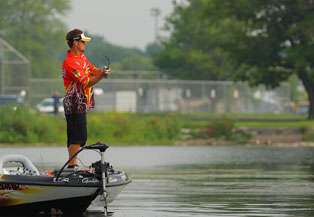
Forgotten Highways
There is no doubt that the most consistently productive submerged roadbeds are those that don't get hammered on a regular basis. Aaron Martens' most memorable roadbed is located in Lake Cachuma, a 3,000-acre lake in California's Santa Barbara County. It runs about 2 miles and features several bridges that were not demolished.
"As a kid growing up fishing that lake it kind of taught me a lot," he recalls. "I'd follow that roadbed, which had bushes and medium-sized oak trees right on the sides of it, and some rock piles next to it.
"I caught some big fish off of that roadbed — 8-pounders — usually on a 6-inch Texas rig worm because I wasn't drop-shotting yet, so I threw a Texas rig about 70 percent of the time. It didn't get much pressure, and I could always catch bass there."
Above-The-Waterline Tip-Off
Martens points out that the entrance and exit points of a roadbed can provide some clues about the submerged portion of the structure.
First, it can offer an idea of how wide the road is and its height off of the bottom. It can also indicate if ditches line the roadway.
"It helps if you can see where a roadbed enters and exits a lake," Martens says. "Like at Lake Logan Martin, there are roadbeds that go through three creeks. You can fish one and then run to the next creek where you can see it come off of the bank into the water. Fish that spot and run to the next creek over. And then run to the next one.
"You can also see what it's made of. It might be asphalt or gravel.
Usually, the asphalt ones are the best ones. Those are a hard surface. After a while they start eroding and cracking off, which makes perfect habitat for crawdads and bluegill, and even bass that hang in those cracks."
Community Hole Tactics
"Because people are aware of them, I think roadbeds are some of the biggest community holes now," Elite Series pro John Crews insists. "On most of the lakes that we go to, roadbeds seem to be something that everybody knows about and everybody fishes.
"So they're not so much of a hidden hot spot as they used to be."
That may be true, but the hard-charging young Virginia pro also emphasizes that these community roadways can still be productive throughout the year, with the exception of spawning season.
It just takes a different approach.
For Crews, that means "throwing something different." Most often, for him that involves fishing a drop shot rig consisting of 8-pound test Berkley 100% Fluorocarbon, a 3/16- or 1/4-ounce weight and a 4- or 4 3/4-inch Berkley Gulp! Slim Shaky Worm or 6-inch Float Worm. In tournament situations, the drop-shot has been successful when following behind other anglers fishing roadbeds with a deep-diving crankbait or Carolina-rigged soft plastic.
One reason for his success could be that he often drags the drop shot along the middle of the road — while others typically concentrate on the outer edges.
"A lot of times I'll just throw it on top of where I know the road is and just drag it slow," he explains. "To me, what I picture in my head going on with that roadbed is there's fish scattered here and there. There may be a hot spot or a sweet spot on that roadbed somewhere, and if you just drag it slowly you'll find it. The fish will tell you where they are."
Martens has enjoyed similar results drop shotting a 4-inch Roboworm and dead-sticking a Zoom Super Fluke.
On popular roadbeds where boats seem to be taking turns strolling down the ribbon of asphalt, he often finds schools of bass suspended off to the side of it in the open water.
"On a cloudy day when you've got 3 feet of visibility and balls of bait but not much wind, you won't catch them on the roadbed," he says. "They will be off suspended away from it.
"That's when you need to throw a jerkbait, topwater or lipless crankbait. Also, a spinnerbait and my Scrounger Head (a jighead with a small plastic lip) are killer for that. It involves more suspended catching techniques."
Whether it is a forgotten roadway or community highway, roadbeds remain one of Aaron Martens' pet places to target.
"I love fishing them," he says. "Wherever we go, I look at roadbeds on a map at every tournament, and I check the ones that look pretty good."




